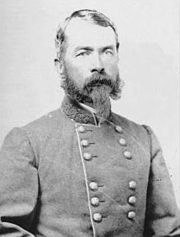Samuel Jones (Confederate Army officer)
Samuel Jones | |
|---|---|
 | |
| Born | December 17, 1819 Powhatan County, Virginia |
| Died | July 31, 1887 (aged 67) Bedford Springs, Pennsylvania |
| Place of burial | |
| Allegiance | |
| Service/ | |
| Years of service |
|
| Rank |
|
| Commands held | Bartow's Brigade Department of East Tennessee Department of Western Virginia Department of South Carolina, Georgia and Florida Department of Florida and South Georgia |
| Battles/wars | American Civil War
|
| Other work | farmer, college president |
Samuel Jones (December 17, 1819 – July 31, 1887) was a
Early life
On December 17, 1819, Samuel Jones was born at "Woodfield", his parents' plantation in
Jones was appointed a cadet at West Point
He was appointed assistant to the Judge Advocate of the Army at Washington and continued in the discharge of the duties of his position until he resigned his commission in the Army of the United States April 27, 1861. Thus immediately prior to the American Civil War he was on the staff of the Judge Advocate of the Army in Washington, D.C.[2]
Civil War
With the secession of Virginia in 1861, Jones was commissioned as a major in the State of Virginia corps of artillery on May 1, 1861 in the military force of Virginia and later was promoted to be Colonel.
He later joined the Provisional Confederate Army and was promoted to
On January 22, 1862, C.S. Army Brigadier General Jones was appointed to the command of the department of which Pensacola was the headquarters. He was promoted to
From April, 1864 to October, 1864, he was in command of the
In February 1865, Jones was named the commander of the Department of Florida and South Georgia, a post he held until the end of hostilities. Here he made one of the last stands of the Confederacy at the Battle of Natural Bridge, and held his position until the surrender at Appomattox, Virginia. He surrendered at Tallahassee, Florida on May 10, 1865.
Postbellum
From 1873 to 1875, Jones served as president of the

Jones died in Bedford Springs, Pennsylvania, and is buried in Hollywood Cemetery in Richmond, Virginia.
See also
- List of American Civil War Generals (Confederate)
Notes
References
- Eicher, John H., and ISBN 978-0-8047-3641-1.
- Jones, Samuel (1911). The Siege of Charleston: and the operations in the South Atlantic coast in the war among the States. New York: The Neale Publishing Company.
- Sifakis, Stewart. Who Was Who in the Civil War. New York: Facts On File, 1988. ISBN 978-0-8160-1055-4.
- ISBN 978-0-8071-0823-9.
- University of Maryland Timeline
